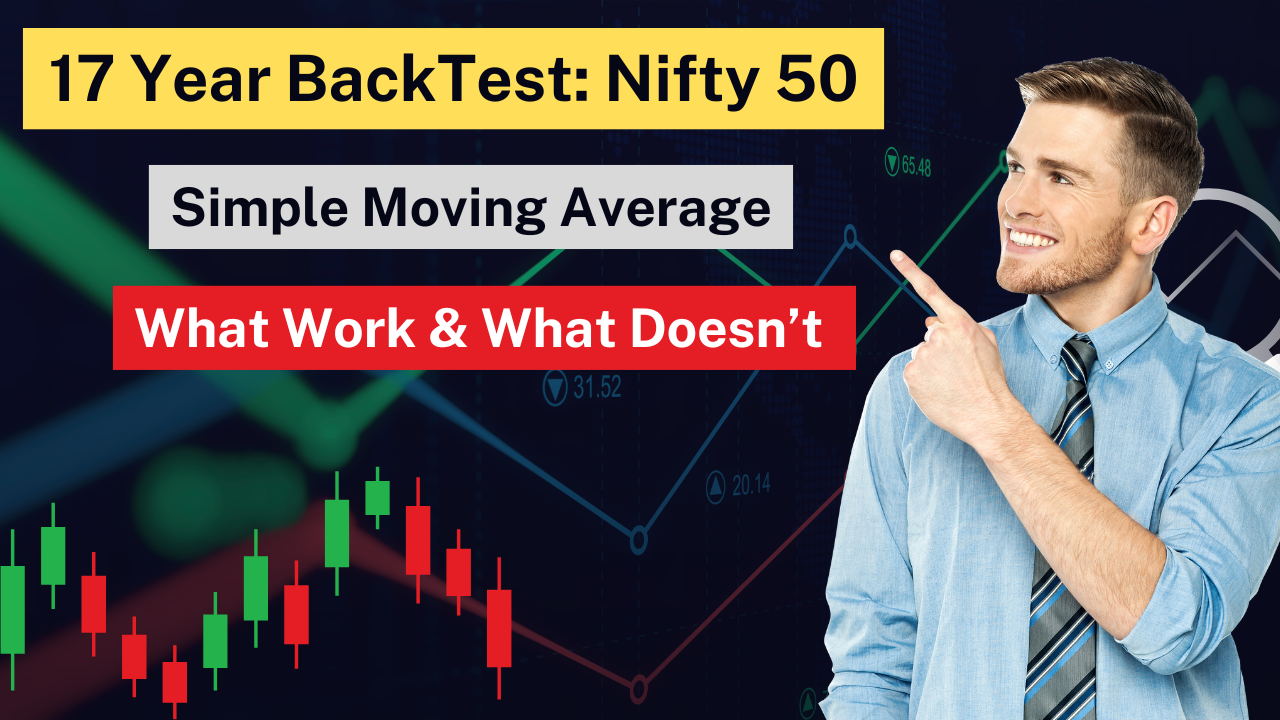Introduction: The Battle of Moving Averages
Have you ever wondered which moving average strategy stands the test of time? With hundreds of ways to trade using Simple Moving Averages (SMAs), it’s easy to get lost in the noise. But what if you had 17 years of backtested data across multiple strategies to tell you exactly which SMA method delivered the best returns with the lowest risk?
That’s what we’re bringing to you today. We tested popular SMA strategies, including the famed SMA 50-200 crossover (Golden Cross), single SMA entries like SMA 21 and SMA 100, and more obscure combinations like SMA 9-21. The results are eye-opening — and maybe even a little surprising.
What Is a Simple Moving Average (SMA)?
A Simple Moving Average (SMA) is a technical analysis tool that smooths out price data by averaging a stock’s price over a specific number of periods.
- Single SMA Strategy: A long position is taken when the price crosses above single moving average. For instance, enter long when the price moves above SMA 100 and exit when it drops below SMA.
- Dual SMA Strategy: Uses two moving averages. A trade is entered when a short-term SMA (like SMA 50) crosses above a long-term SMA (like SMA 200) — known as a Golden Cross — and exited when it crosses back below.
These strategies aim to ride the trend, whether up or down, and avoid getting caught in short-term price noise.
Terminology Simplified
Before we dive into results, let’s break down some key terms used in strategy analysis:
- CAGR (Compound Annual Growth Rate): The yearly return generated by a strategy if profits were reinvested annually.
- Sharpe Ratio: Measures return relative to risk. Higher is better.
- Sortino Ratio: Like Sharpe, but only considers downside risk.
- Calmar Ratio: Return divided by maximum drawdown. It highlights how much pain is involved in gaining returns.
- Max Drawdown (DD): The biggest drop from peak to trough in your equity.
- Avg. Drawdown Duration: Average length of time the portfolio remains in a drawdown.
- Profit Factor: Total profit divided by total loss. >1 means a profitable system.
- Expectancy: Average gain or loss per trade expressed as a percentage.
- Win Rate: Percentage of profitable trades.
- # Trades: Number of trades executed during the backtest.
- SQN (System Quality Number): Measures the quality of a trading system considering risk-adjusted returns and consistency.
The 17-Year Backtest: Setup
- Duration: 2007 to 2025 (17+ years)
- Tested On: Nifty 50 Index
- Platform: Back testing Algorithm.
- Assumptions: No leverage, long-only trades, 0.1% Brokerage
- Strategies Compared:
- Dual SMA Strategies:
- SMA 9-21 crossover
- SMA 50-200 crossover (also known as Golden CrossOver)
- Single SMA Strategies:
- SMA 7
- SMA 21
- SMA 50
- SMA 100
- SMA 200
- Dual SMA Strategies:
Performance Comparison Table
Single SMA Strategies
| Strategy | SMA 7 | SMA 21 | SMA 50 | SMA 100 | SMA 200 |
|---|---|---|---|---|---|
| CAGR (%) | 2.77 | 6.45 | 5.57 | 7.25 | 6.26 |
| Sharpe | 0.22 | 0.49 | 0.44 | 0.6 | 0.49 |
| Sortino | 0.24 | 0.59 | 0.52 | 0.76 | 0.63 |
| Calmar | 0.06 | 0.15 | 0.12 | 0.26 | 0.16 |
| Max DD (%) | -31.34 | -27.87 | -30.55 | -18.65 | -26.32 |
| Avg DD Duration | 139 days | 81 days | 77 days | 65 days | 65 days |
| Profit Factor | 1.46 | 1.93 | 2.07 | 3.71 | 3.75 |
| Win Rate (%) | 36.89 | 38.65 | 40.98 | 45.07 | 44.44 |
| Trades | 422 | 207 | 122 | 71 | 63 |
| Kelly | 0.15 | 1.17 | 1.16 | 1.25 | 1.23 |
| SQN | 2.66 | 2.47 | 1.89 | 2.72 | 2.63 |
| Expectancy (%) | 0.32 | 0.66 | 0.72 | 0.88 | 0.77 |
Dual SMA Strategies
| Strategy | SMA 9-21 | SMA 50-200 |
|---|---|---|
| CAGR (%) | 2.98 | 5.11 |
| Sharpe | 0.24 | 0.4 |
| Sortino | 0.25 | 0.46 |
| Calmar | 0.07 | 0.17 |
| Max DD (%) | -29.38 | -41.54 |
| Avg DD Duration | 162 days | 60 days |
| Profit Factor | 1.56 | 3.83 |
| Win Rate (%) | 43.86 | 63.64 |
| # Trades | 114 | 11 |
| Kelly | 0.14 | 0.42 |
| SQN | 1.37 | 1.31 |
| Expectancy (%) | 0.45 | 1.02 |
Key Takeaways
🌟 SMA 100: The Best All-Rounder
- Top CAGR (7.25%) and best risk-adjusted metrics.
- Lowest drawdown and highest Kelly and SQN.
- Strong balance of return and reliability.
📊 SMA 50-200: Precision with Patience
- Best Profit Factor and Win Rate.
- Few trades but highly selective.
⚠️ SMA 7 and SMA 9-21: Too Much Noise
- High trade volume with subpar results.
- Lower profit factor and Sharpe ratios.
- Suitable only for high-frequency systems with tight controls.
Can We Say SMA Works?
The average Nifty 50 return over the last 17 years is approximately 11% CAGR. All SMA-based strategies underperformed this benchmark, with SMA 100, the top performer, achieving 7.25% CAGR.
This suggests that while SMAs may help with risk management (e.g., lower drawdowns, smoother returns), they do not outperform buy-and-hold strategies over the long term.
Hence, one might conclude that Single and Double SMA-based strategies do not beat the market alone and should not be used.
What’s Next?
Want a downloadable Excel sheet, Python code, or strategy dashboard for this SMA comparison? Let me know in the comments or reach out through our contact form.
Also, subscribe to our YouTube channel for tutorials, tips, and backtest breakdowns on popular trading strategies.
